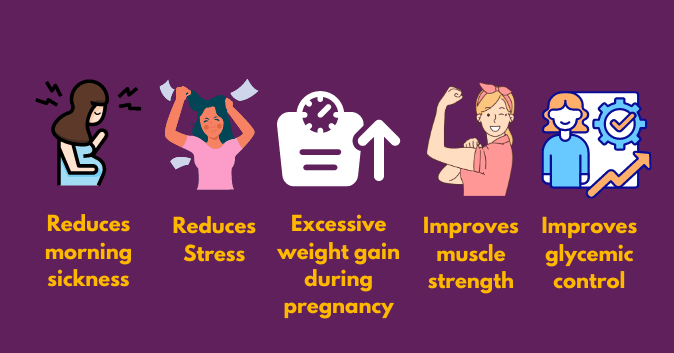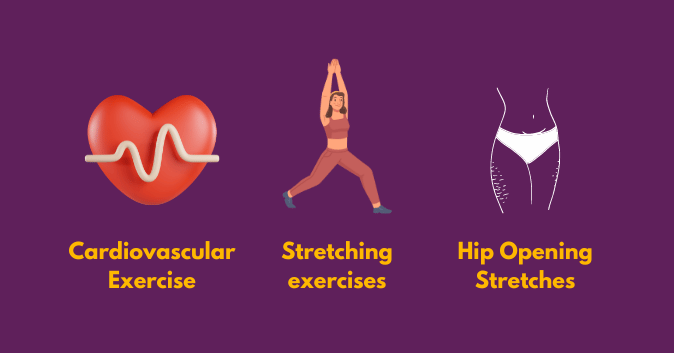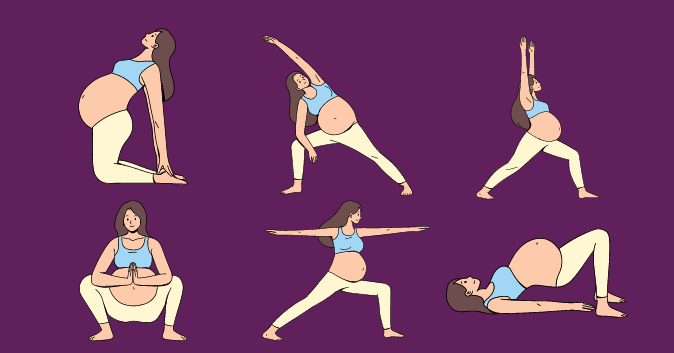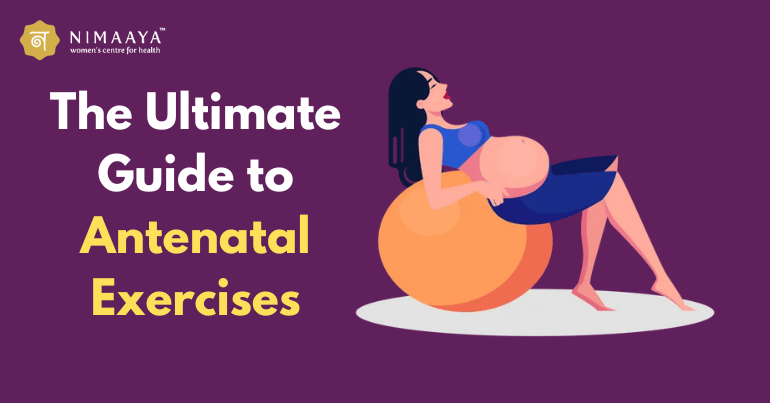Antenatal exercises aim at improving the physical and psychological well-being of an expectant mother for labor and preventing pregnancy-induced pathologies by various physical means. It generally includes low-impact aerobic exercises and stretching exercises.
Pregnancy causes certain physiological changes in the first trimester, such as morning sickness, lethargy or poor energy, nausea, and increased relaxing hormone release. The mother’s attitude and energy level improve with exercise, which also helps her handle these changes. Healthy pregnant women should exercise for at least 150 min per week or 20-30 min every day at moderate to vigorous aerobic intensity.
Benefits of Antenatal Exercises

- Reduces morning sickness.
- Reduces insomnia, anxiety, and stress.
- lessens other pregnancy-related symptoms such as edema of the limbs, leg cramps, and exhaustion.
- Prevents excessive weight gain during pregnancy.
- Improves muscle strength.
- Improves core stability.
- Maintains muscle length and flexibility.
- Improves glycemic control.
- Improves posture.
- Enhances relaxation.
- Prepares for physical demands of labor.
Also Read: Top 5 IVF Centers in Vadodara
Contraindications
There are absolute contraindications and relative contraindications.
❧ Absolute contraindications
- Ruptured membranes
- Premature labour
- Unexplained PV bleeding
- Placenta previa after 28 weeks
- Pre-eclampsia
- Incompetent cervix
- Intrauterine growth restriction
- Higher-order multiple pregnancies (e.g., twins, triplets, etc.)
- Other serious cardiovascular, respiratory, or systemic disorders
❧ Relative contraindications
- Recurrent pregnancy loss
- Gestational hypertension
- A history of spontaneous preterm birth
- Mild/moderate cardiovascular or respiratory disease
- Symptomatic Anaemia
- Malnutrition
- Eating disorder
- Twin pregnancy after the 28th week
- Other significant medical conditions
❧ Precautions
- Exercises should be performed under supervision.
- Avoid supine lying for more than 5 minutes after 3 months of gestation.
- Do not hold your breath(Valsalva’s maneuver).
- Do not change positions quickly.
- Stay hydrated all day.
- Follow the proper warm-up and cool-down process.
- Ensure bladder emptying before workouts.
- Avoid exercises that demand higher balancing and different groups of muscles.
❧ When to seek medical care?
- Excessively shortness of breath
- Chest pain or palpitations
- Dizziness
- Vaginal bleeding
- Abdominal pain
- Reduced fetal movement
Let’s take a glance at the various forms of exercises that can be performed during pregnancy!
Types of Antenatal Exercises

➛ Cardiovascular Exercise
- The intensity of the workout will be decided by an assessment of pre-pregnancy cardiovascular fitness level.
- It is crucial to select any aerobic exercise, such as walking, swimming, hiking, etc., suited to one’s interests.
- Walking can therefore be safely done for 20 to 30 minutes, three to four times a week, if that is all the individual does for cardio exercise.
➛ Stretching exercises
✔️ Pectoral stretch
- This exercise avoids the development of round shoulders and aids in chest opening.
- Push the ball into the wall or the corner.
- Maintain the back of your chair on the ball while you sit comfortably.
- Keep your hands by the side.
- Rest the head on the ball let the elbows expand and open your chest.
- Repeat 3 to 5 times.
✔️ Piriformis stretch
- The Piriformis muscle plays an important role in pelvic stabilization and ADLs.
- Maintain a neutral pelvis while seated in the chair.
- Now keep your foot over the opposite knee and bend forward from the hips keeping your pelvis neutral until you feel the stretch.
- Hold it for 20-30 seconds.
- Repeat for the other side as well.
- Do 3 to 5 sets.
✔️ Hamstring stretch
- Shortening of the hamstring can cause back pain and pelvic misalignment.
- This stretch exercise can be performed in various positions.
- Sit in a long sitting position, bend one knee, and try to reach your extended leg as much as you can.
- Hold it for 20 to 30 seconds, then switch to the other side and repeat 3–5 times.
- During the first trimester, supine lying hamstring stretch can also be done.
✔️ Calf stretch
- The more the available length of Tendo Achilles, the more force production during the push-off phase of walking and greater stability.
- Put a foam roller, mat, or rolled towel down on the ground.
- Place the ball of the foot on the towel, mat, or roller and heel on the floor. keep the leg straight. hold this position for 20-30 seconds.
- Perform three to five sets on each side, then switch to the other side.
➛ Hip Opening Stretches To Do During Pregnancy
✔️ Butterfly / Tailor Pose
- sitting on the ground, bring the soles of the shoes together, allowing the knees to point out to each side.
- Grasping feet or ankles, draw both heels in as close to the body as is comfortable.
- Lean forward slightly and hold that position. Concentrate on inhaling deeply from the belly.
- Press your thighs down with your hands or elbows to bring your knees closer to the floor for a deeper stretch. As you hold that position, concentrate on your breathing and the stretch.
This is an excellent stretch for opening up the hips, groin, and inner thighs. This pose not only helps widen your hips but also helps ease aches in your lower back.
✔️ Squats / Garland Pose
- Stand with feet facing forward, shoulder slightly wider than hip-distance, apart.
- Slowly and fluidly bend your knees and lower your body, extending the arms out in front for balance if helpful.
- Take a moment to balance your weight on the balls of your heels.
- Take a breath, slowly raise back up, and then do it again.
✔️ Hip Flexor Stretch
- To make your leg create a right angle, kneel on your right knee and place your left foot in front of you.
- For balance, place your left hand on your left thigh and your right hand either on your right hip or on your left thigh.
- Keep your back straight, lean forward, and shift your body weight to the forward leg. Your right thigh will feel stretched.
- Repeat by switching legs after 30 seconds of holding.
✔️ Seated Straddle
- With your feet flexed, spread both of your legs wide.
- To assist in straightening your spine, firmly plant your pelvis and hamstrings into the ground.
- If this is sufficient to stretch the backs of your legs, hold on to this position or extend your hands in front of you.
Strengthening Exercises for Antenatal Mother

Wall push-ups
- Place hands shoulder-width apart on a wall,
- Take a step back with your feet to assume an inclined plank stance.
- Slowly lower your chest, making sure your body stays in alignment.
- Breathe out as you return to the starting position of the plank.
- Repeat 5-10 times.
Single Arm Rows & Seated Row With Resistance Band
Using a bench to support the body means less stress on the core, and focusing on one side at a time can help to concentrate on back muscles stretching and contracting.
To start this exercise, find a bench or platform that’s long enough to support the knee and hand on one side of the body. Use that same side hand to grab the dumbbell. Row the weight up towards the armpit with the elbow coming up above the back. While maintaining a firm and dynamic posture with the standing elbow, flex the back muscles on that side. Do not rotate the body at all, and keep the chest facing down throughout the movement. Repeat after carefully putting the dumbbell back in its stretched beginning position.
✔️ Bridging
- This exercise puts more emphasis on the gluteus maximus and other larger postural muscles.
- Lie on your back, hands by your side, knee hip-width apart and heel under the knee.
- Squeeze your buttocks and raise your pelvis while maintaining a neutral pelvis.
- Hold it for 10-20 seconds, and breathe regularly.
- Come back to the starting position slowly.
✔️ Squats
- Great exercise for all the lower extremities muscles majorly focusing on the gluteus maximus.
- Stand feet slightly more than hip-width apart.
- Clasp the hands and bring them forward.
- Squat while exhaling and make sure your knees won’t go beyond the great toes.
- As you go up, apply force and extend your legs.
- Ensure the stability.
✔️ Lunges
- This exercise put more emphasis on the gluteus, Hamstring, and Quadriceps
- Stand straight, and take one step forward.
- Now, lower yourself and try to maintain the front leg vertical so that the gluteus and hamstring will be loaded rather than quads.
- Pressing the leg down straighten yourself.
Third Trimester Specific Exercises
- Step one in the duck walk is to stand with your feet wide apart and your arms by your sides. While performing the exercise the abdominal muscles must be in a tightened position so that the back and abdominal muscles are not accidentally injured.
- Thereafter one should be required to lower the body from the hips as if an individual were about to sit on a chair, ensuring that the heels bear the weight
- The knees won’t sustain any harm in this manner. clasping hands together in front of the chest helps to maintain balance during the duck walk.
- Once in the required position, progress walks forward a few steps at a time without changing squat position, then turns around and walks back to the place from where started and slowly stands up. It is recommended that to maintain balance when practicing the duck walk exercise, a person should lean forward and keep their weight on their heels.
It will make their thighs stronger and make it easier for the baby’s head to descend. Duck Walk is highly effective in facilitating easy & normal labor/delivery.
Guideline for Antenatal exercises
Guidelines to ensure safety and Well-being Antenatal Exercise in pregnancy
▸ Do’s
- If you have been following a regular exercise program before your pregnancy, maintain that program to some degree throughout your pregnancy.
- If you are a beginner, you should start very slowly and be careful not to over-exert yourself.
- Regular exercise sessions – at least 3 times per week – are safer than intermittent bursts of activity
- Careful ‘warm–up’ should precede vigorous exercises which must be followed by -cooling down or a gradual decline in activity.
- Include relaxation and stretching both before and after the exercise program.
- Eat a healthy diet that includes plenty of fruits, vegetables, and complex carbohydrates.
▸ Don’ts
- Avoid jerky, bouncing, and ballistic movements and activities.
- Avoid exercise in extremely hot weather.
- Mother’s heart rate should not exceed 140 beats per minute and vigorous exercises should not be longer than 15 minutes.
- Avoid contact sports.
- Do not overbend any joints.
- Stop exercises immediately if you experience symptoms such as
- chest pain,
- blurred vision, dizziness, fainting,
- irregular heartbeats,
- increase swelling in your hands, feet, and ankles, and
- Sudden change in body temperature.
- During the second and third trimesters, avoid exercises that involve lying flat on your back as this decreases blood flow to your womb.
Conclusion of Antenatal Exercises
Antenatal exercises offer numerous benefits for both the mother and baby during pregnancy. By incorporating a variety of exercises into your routine and following safety guidelines, you can stay active, reduce discomfort, and prepare your body for labor and delivery. As you begin any fitness regimen, don’t forget to speak with your healthcare practitioner and pay attention to your body’s needs during your pregnancy. We at Nimaaya IVF Center are committed to offering expectant moms all-encompassing assistance and direction during their pregnancy journey, guaranteeing a seamless and healthy transition into motherhood.


